I admit it — if fava beans weren’t so good for the soil, I likely wouldn’t grow them at all, edible or not. Hidden inside those fat long pods are handfuls of delicious beans, but they make you work for it. Really work for it.
Shelling the beans is a labor-intensive process, one that should be done on a (not so) lazy Sunday around the kitchen table or on the back porch while you watch your kids play. You might even enlist your kids to help, or bribe a friend to do it with you. It’s a lot of time to spend on a bean.
But despite the seemingly neverending shucking involved, fava beans have a buttery goodness that you don’t find in other beans, making the toilsome undertaking a true treasure hunt.
Fava beans (Vicia faba) are also known as faba beans, broad beans, horse beans, field beans, and Windsor beans. These Old World beans hail from Europe and are among the most ancient crops to be cultivated, dating back to at least 6000 BC.
The fava bean is a prolific, low-maintenance variety grown in cool weather. In my zone 10b climate, I sow seeds in the fall and harvest beans through winter and spring. (They can also be started in spring and harvested through summer.) They are unaffected by cold conditions and clay soils, but are susceptible to rust, a fungal disease of the leaves.
Fava beans grow as rigid, upright plants from 2 to 5 feet tall and often require staking as they mature.
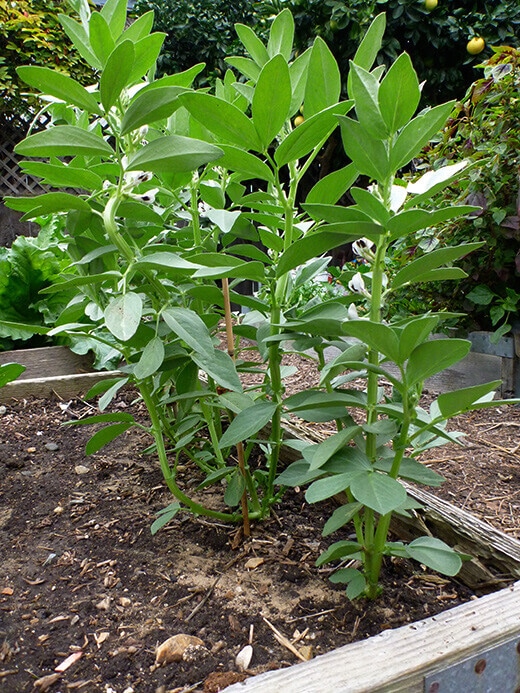
The young leaves are pale green, tender and delicious. Yes, you can eat them! (And unlike the beans, which are a chore to prep, fava leaves are ready to eat right off the plant. If you want to grow favas for their nitrogen-fixing properties but fend off the guilt of not harvesting the beans, just eat the leaves!)
Trim the tender tops off your plants and make a salad with other seasonal favorites, like spinach and citrus. Fava leaves have a sweet and nutty flavor, just like the beans.
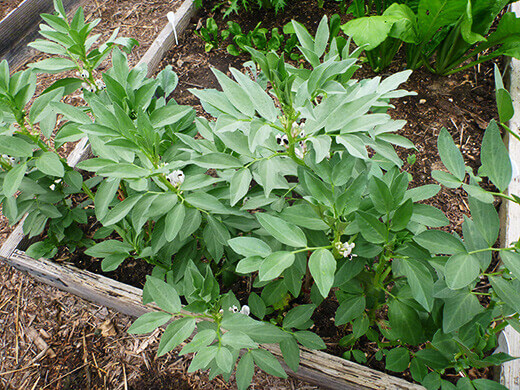
The beautiful flowers bloom in clusters and are reminiscent of orchids.
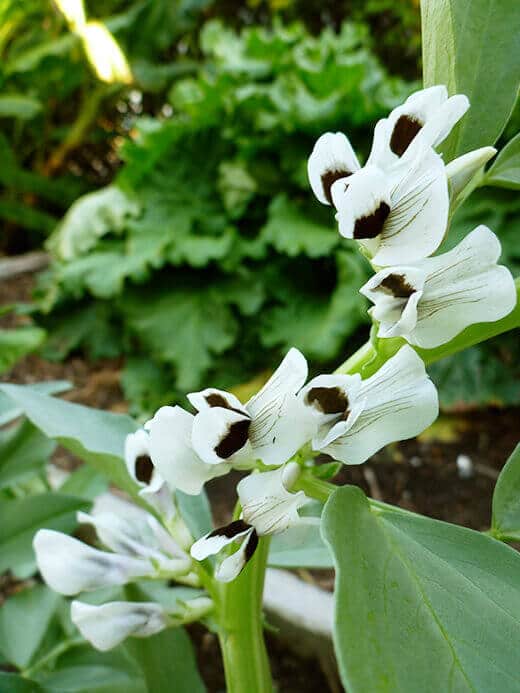
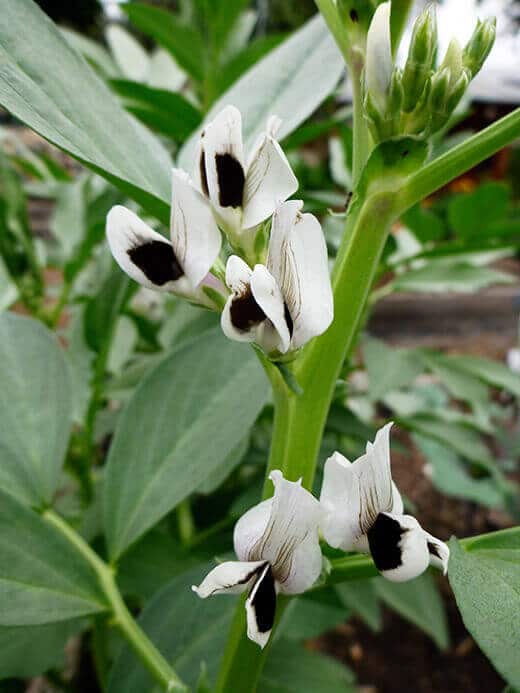
The fruit from these flowers grow as long, dense, bright green pods. Picked early, while the pods are still skinny, fava beans can be eaten whole like any other bush bean.
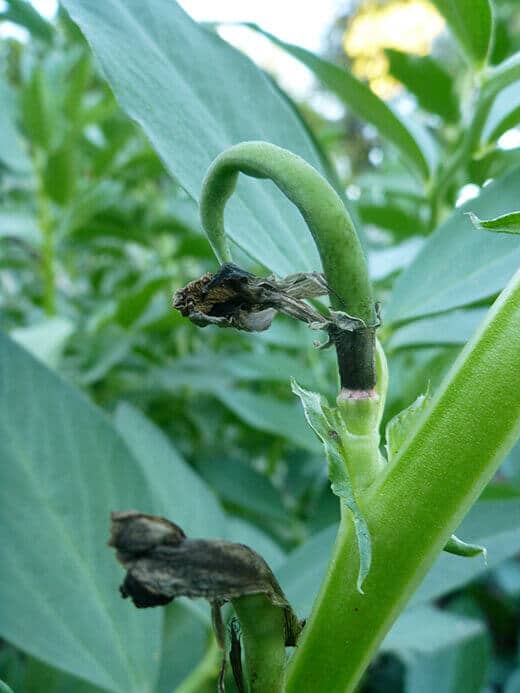
But if you wait until the pods reach 6 to 8 inches long, you’ll be treated to the delectable beans favas are known for.

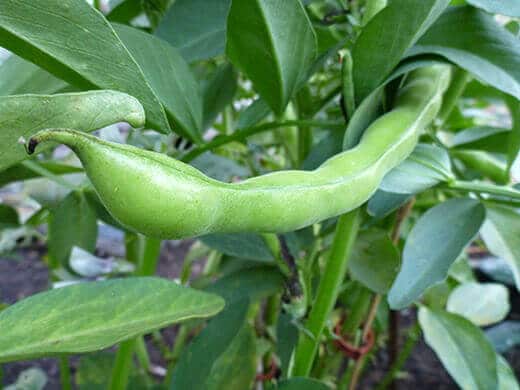
Harvest the beans when the pods are large and bright, but not over-bulging.
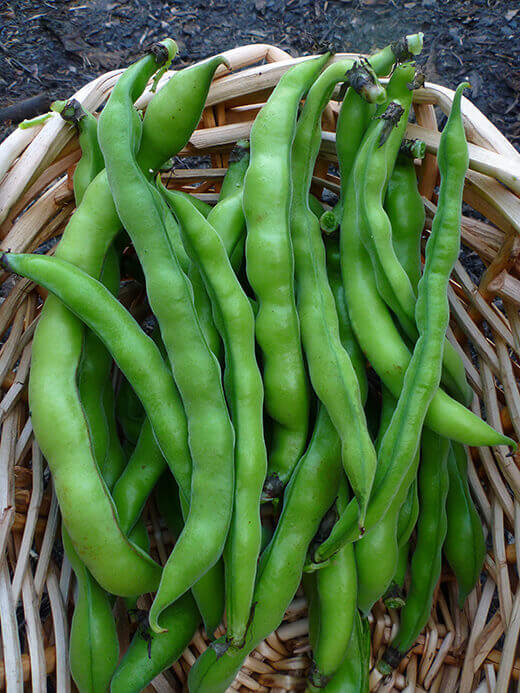
To start shucking the bean, start at the pointy end of the pod and snap back the tip with your finger.

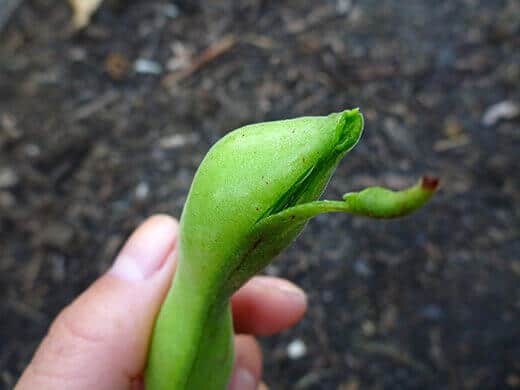
Peel back the string until the pod is completely split along its seam.
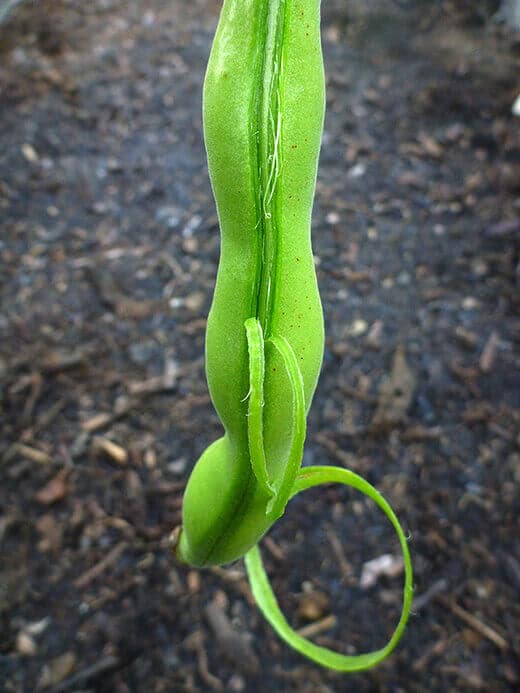
Once the pod is split open, you’ll find a row of beans inside, but these are not the actual beans you’ll eat (trust me, I’ve tried).
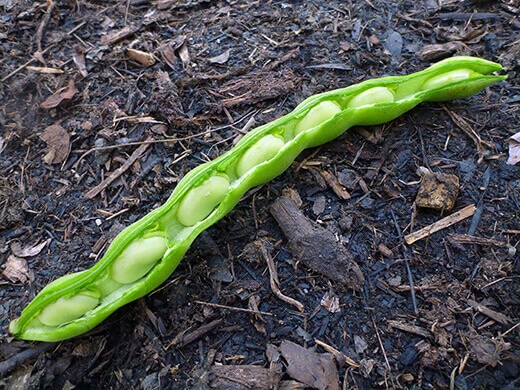
Each bean is covered with a thick, waxy shell that you have to shuck to get to the goods.
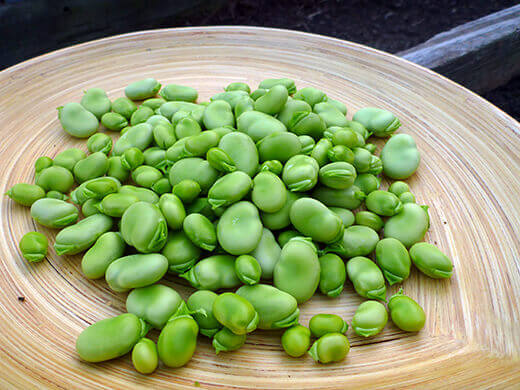
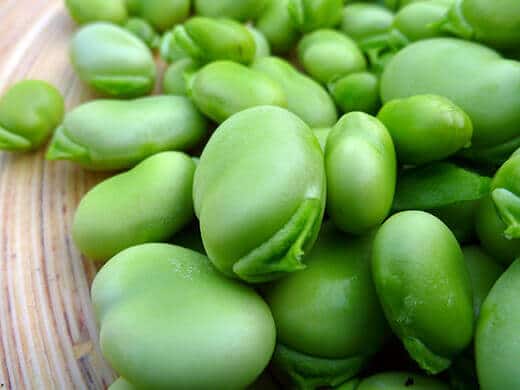
The easiest way to do this is to parboil the beans for no more than a minute.
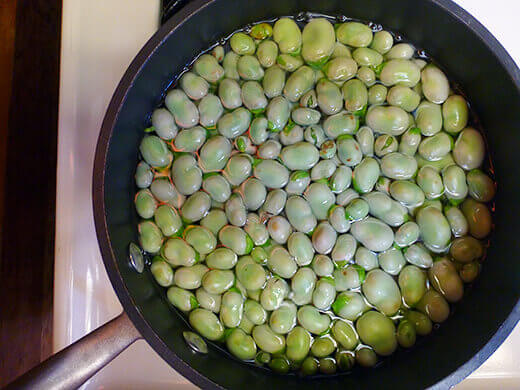
Strain them, then dunk the beans into an ice water bath to stop them from cooking.
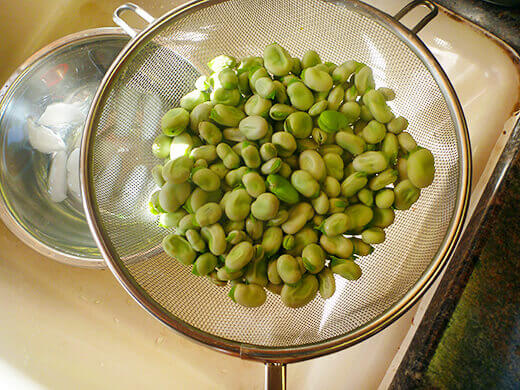
You may notice that some of the outer shells (now a dull grayish-green) have started to split open, revealing vibrant green beans inside.
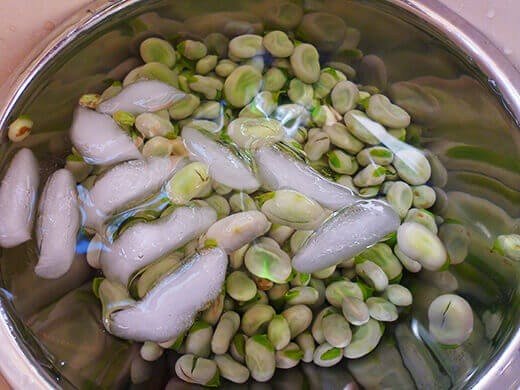
Now that the shells are soft and pliable, it’s quite simple to squeeze the sides and pop out the bean. You can also slice the top of the shell with your fingernail and squeeze the bean out that way.
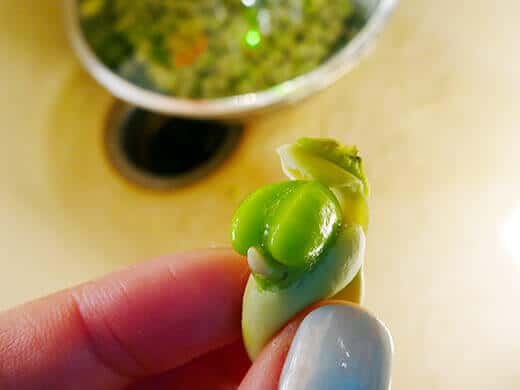
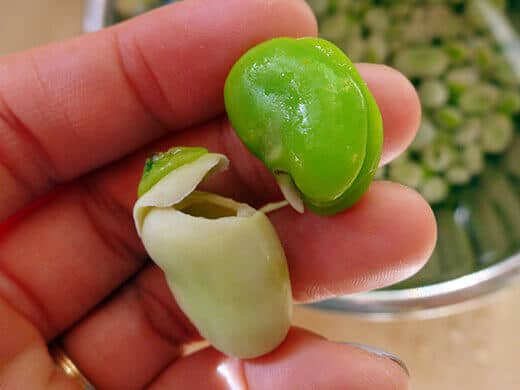
In general, a pound of pods yields around a quarter-cup to a third-cup of shelled fava beans. At that rate, you can see why this process calls for a lot of patience and perhaps a glass of wine while you work!
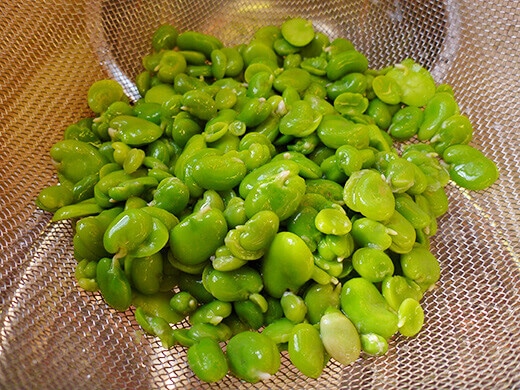
My favorite way to prepare fava beans is in a risotto with little more than onion and butter. The simple recipe really lets the smooth and rich flavors of the favas shine.
In fact, you can even make an all-fava meal, starting with a fava leaf salad (add sliced oranges, crumbled feta, chopped walnuts, and a drizzle of vinaigrette), a fava leaf pesto for your linguine, and a side dish of fava beans sauteed with garlic and shrimp. I haven’t yet found a way to incorporate fava beans into dessert (fava bean ice cream, anyone?) but I’ll report back if I do!


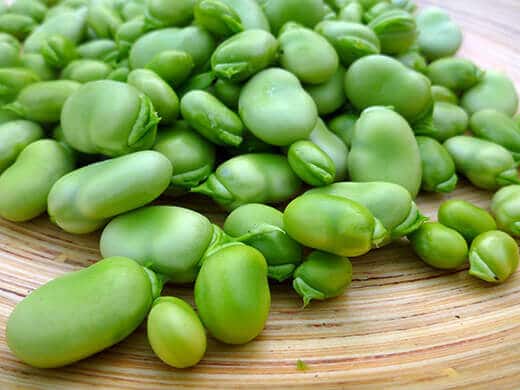













I put a little olive oil on the pod and grill them. They pod get blistered and soft and I pop out the beans and eat the beans without pealing the outer layer.
With young fava beans you can grill them whole and eat it all, pods included.
Nice! Thank you.
Thanks for your informative post. I tried favas this year. I don’t have much space so I tried 2 plants in soil and a bunch in containers. The ones in the containers did not do so well, but the two plants in the soil did great (even though that soil is not very good). I’ve got a bunch of pods now. Didn’t know you could eat the leaves.
Sorry if its been asked i tried looking. I like to buy large bags of beans dried. I’ve been looking for ways to be more self sustaining. Is it possible to dry these like black beans or Pinto beans?
Yes, you can dry fava beans but I’m not sure it’s worth the effort if you plan to eat them later. You’d have to cook and peel dried fava beans to get the really tender beans inside. An Instant Pot might help with that, however. Worth a try!
Wonderful article, thank you. Fava beans grow so well in the maritime Pacific Northwest and we’ve learned to slice them diagonally in the pod about 1/4 inch thick and stir fry them in olive oil and with salt and pepper. They are delicious this way – and easy peasy!
If you harvest in the green immature stage, you don’t need to peel the outer covering of the seeds, a tedious job. I leave it on and they are good to eat that way. Once the seeds harden you will want to peel them and eat just the inner bean.
Someone gave me fava beans to plant. They are a mutated variety she had been working on for years. They are black. I’m sort of scared to plant them, afraid I’ll mess them up. But I’m going to try them.
Good luck, they sound beautiful. 🙂
THey bloomed, I picked. No more beans from plants?
Occasionally you may get a second round of beans, but if there are no more flowers to be found, you can harvest the leaves to cook with.
Thank you.
Years after you posted it is still helpful to people. The photos were great to show what colored outer shells would look like after being parboiled. Thanks.
You’re welcome!
This was the perfect article that I was looking for. Thanks. Just spent the better part of it afternoon and shelling fava beans and now my wife is making them into a nice soup. Thanks for the advice
You’re welcome, I’m glad you found it helpful!
Great blog!! This is my first time growing fava beans and now that I’m getting beans was wondering when to harvest, how to shuck, etc.. And I’m going to try some leaves in my salad of mixed greens from my garden today! The only question I still have is the best way to preserve and store.
If you want to preserve fava beans in their original state, the best method is to blanch the shelled beans and them freeze them.
Thank you. I’ll give it a try. Grace
Very informative article. I bought dried fava beans at a health food store. Do you think I could plant a few of these store bought dried beans to see if they will grow??? Grace
You definitely can. Just soak the beans overnight before planting. I had 100% germination.
I grew up eating these beans (dry and green), there is no right way to prepare them but here is what I do with them when green: either cook them as whole (with the pod), just with water, salt and spices; or chop them with the pod and cook them. Basically treat them like garden beans. The pod is actually delicious when cooked, so is the shell. I find the bright green inside too thick and rich, the shell and the pod ad some fiber to balance.
Alternatively, just leaving them on the plant until they dry gives you the dry beans. With the dry ones you definitely have to throw away the pods but cook the beans with the shell; I sometimes eat the cooked dry beans with the shell or shell them while eating.
Wonderful guide! I’ve grown Broad beans for the first time this year (we had a particular cold Winter here in Victoria, Australia) and I look to have a bumper crop growing – your guide is perfect for me – now I know when to harvest and how to prepare them – thank you. Would you have that risotto recipe written anywhere? Thanks again.
I’m glad this has been helpful for you! The fava risotto recipe is not online, but you can find it in my book, The CSA Cookbook. http://www.thecsacookbook.com (For Australian readers, Book Depository offers free shipping.)
Okay, definitely let my fava beans get too far along… any words of wisdom?
If the pods have started to turn purple/brown, you can let them dry up and save the seeds for planting next season. But if they’re still fully green, they should still be edible so long as you shell them.
I did and they were – thanks!
For fava beans as a desert look to japanese wagashi (tea treats). Fava beans are used to make sweet bean paste for filling the snacks. However it can also be mixed 50/50 with buttercream and used to ice a cake, it is just a sweet and buttery and no one will ever know that it’s healthy(er).
This is so interesting. I love that idea–and what a pretty green buttercream!
Last November I planted Fava bean seed in my 3 vegetable boxes, for soil benefits, not expecting any harvest. Most of the seeds sprouted and grew happily up to 3-5 feet. In the box on the sunniest spot, the plants began flowering in January. It has been a warm winter here on the central coast of California. The sunny-side box will give me a harvest starting this week and it has a bunch of pods 4-6 inches long and a bunch more just beginning. Thank you for your website and the helpful information you provide.
You’re welcome! Thank you for reading my blog and enjoy your fava harvest!
This winter was my first time planting fava beans and while I get flowers, I get no beans. I was trying to figure out why. Perhaps I spaced them too close together? But thanks for the tip on eating the leaves! Will add some to a salad tonight! I love eating the greens on my winter crops, like romanesco and cauliflower!
Failure to fruit (produce beans) may be due to insufficient sunlight. While favas can tolerate partial shade, they still need at least 6 hours of direct sun per day. It can also take up to a month for a flower to produce a pod, so maybe yours hasn’t reached that stage yet.
Thank you! Patience was all that was necessary! At last, some fruit has arrived!
Broad beans are insect pollinated so with low insect activity in the dead of winter, flowers don’t become beans. Here anyway.
Broad beans are partially self-pollinating. The plants just have greater yields if insects “trip” the flowers.
You mentioned that you sometimes get a second crop in the same season…I planted four beans in a container (first attempt so an experiment of sorts) and while all four grew, one one is still spindly and puny; and the other three flowered but I have only one pod growing on each. Did the other flowers not get pollinated, or could there have been some insect or disease at work? And back to your comment – will the stalks flower again? There hasn’t been much work involved thus far apart from sticking the beans in the dirt/compost and keeping the plants watered; but I was hoping for more of a payoff than this. Are these three pods all I should expect?
Fava beans are fairly large plants (mine grow up to 4 feet tall), so depending on how large your container is, there may not be enough room for them to grow. I space mine about every 8 inches. If you plant them closer than that, then yields will be dramatically reduced.
Just came across your blog today as I was searching for tips on how to grow a variety of vegetables, seeing I’m an organic farmer who has experienced some troubles with a few crops. Anyway, I have to say I’ve been learning a lot thanks to your blog! It’s super helpful and fun to read, so congratulations! I’m commenting mainly because I had never heard of shucking fava beans. They are a very popular crop here in Portugal and I personally love to eat them in stews, but we never take the skin off of the beans. They do become rubbery and a little bitter if the beans are picked too late, but if you pick them early, they are tender and sweet, even with the skin on. Didn’t know the leaves were good to eat either – have yet to try them, but it won’t be this year. My fava beans are still producing at the moment, but the leaves are in quite bad shape since the plants were badly affected by aphids (nasty little things, I truly hate them) and some have a bit of rust, too. Hopefully I’ll manage to get a healthier crop next time. Thanks for all the info and happy farming!
You can certainly eat fava beans whole when they’re young and slender (like green beans). Shucking is reserved for the larger pods, which is what we often harvest or find at farmers’ markets here in the US.
Thank you for reading my blog, I’m glad you’re finding it useful!
Hi! I’m planning on planting these in my garden this year– I’m in Canada, the map says I’m in zone 4a, so I’m wondering how to determine when to plant them, in regard to frost? Also, my in-laws from Algeria also eat the large mature pods, juuust before the pods get really hard, but they get much bigger than the tender ones you showed in the picture of the edible pod ones.
They remove the tough seam strings that you remove for shelling, cut them in pieces with their fingers so that each bean has its share of the casing, and steam them for 40 minutes to an hour, adding some shelled peas, olive oil and couscous in the process, and eat with buttermilk and boiled eggs. The casings give the dish a delectable, unique taste, and I’ve made it and the beans were as big as the ones you showed on the mature bean picture! I’m sure they’d also be delicious in a stew.
Anyways thank you for your wonderful website, I’m learning so much and excited to get planting this spring and summer (there is still snow on the ground here but it is melting fast!).
Greetings from Japan… just found your blog when I was checking if fava bean leaves were edible… hmmm, looks like I shall be picking off the top, tender leaves this coming weekend…. thanks, and happy gardening…
Enjoy them! And the leaves from all bean plants are edible, too. I offer recipes for these in my new book: http://thecsacookbook.com
can these be dried like a lima bean or navy bean and if so do you leave the last shell on??????????????????/
Yes, dried fava beans are common in Latin cooking and I’ve seen them shelled, double shelled, and even split. It likely depends on how you’ll want to prepare them later.
Love your site. I am hoping you may answer a question for me…I would like to know when to harvest fava beans and if they mature all at once or throughout the season. If they mature all at once I want to plant another crop in their place once finished. I can not wait to try them! I have a sister-in-law who loves them and loves that I am growing them. I don’t think she has eaten the leaves yet, so I will have to make her a salad next time she is over. Thanks for you time.
I pick mine at 6-8 inches long, just the way you see them in the pictures. They don’t mature all at once, but do so within a few of weeks of each other. Oftentimes I’ll get a second crop from my plants.
Hi Linda I came across your blog awhile back when looking into whether broad bean leaves were edible. Such a lovely site over all. I grew another crop and tried the leaves for the first time today. Such an interesting flavour raw. Still bean esque. I cooked some garlic creamed spinach style (which is normally what i do with silver beet apart from a yellow silverbeet curry) as a side. Yumo! Anyway greetings from Melbourne and happy gardening and cooking 🙂 Kris
Thank you Kris! Happy cooking to you too. It sounds like we share a great curiosity for all the edible crops in our gardens. 🙂
You’re welcome! Enjoy the fava leaves in a salad or saute… even a soup. They’re abundant in spring.
I did not realize that you could eat the leaves. I will be sure to try this this year as well as blog about it. Thanks for the excellent post and the inspiration!
-Eric
http://www.thepeaproject.com
I grew favas once, and unfortunately, I didn’t get a good enough yield to justify the effort. But, what I’m wondering is…how many plants do you plant? I don’t have a ton of space and I think my harvest would be a “one and done” (perhaps enough to make the risotto!). I do love them though, and would like to try again. There’s just my husband and me, so how much should I plant?
I plant my favas about 6-8 inches apart, so I get about 6 plants within a 4-foot row in a standard raised bed. That’s enough to yield beans for risotto (with plenty of greens for a fava leaf salad as well). Since the plants grow tall and skinny, I feel they fit better in corners and other unused spaces around the garden, so I stick a seed wherever I have an 8-inch square patch of soil against a wall (or wherever it won’t block the sun).
Hey, thanks so much for this post! I’ve got some broad/fava beans in flower at the moment, and can’t wait till they form pods. Didn’t know you could eat the leaves though! Will have to try those in a salad.
You can eat whole fava beans unshelled when they are young, similar to the way you eat green beans. But when the pods are mature, they’re much too tough to chew, even after cooking. Mature beans should be shelled if you want those yummy beans inside.
I have an Italian friend who introduced me to Favas. She gets hers from a friend. She doesn’t shell them, never does when they are fresh. She said that is only necessary when they have been dried.
My favas are happily growing, even with our cold weather…and I look forward to yummy favas.
Nancy
http://wildoakdesigns.blogspot.com
Sabrina Lee liked this on Facebook.
Ann Martin liked this on Facebook.
Kitchen Garden Maui liked this on Facebook.
Larry Peitersen liked this on Facebook.
You’ve inspired me to buy some fava bean seeds and start my own! I love risotto, so now I even know what to do with them. 🙂
Yay!
We call them broad beans here in Oz, although just as delicious I’m sure!
I grew a beautiful heirloom scarlet flowered variety last winter and the beans that resulted were much smaller and could be eaten young without shucking.
The large beans from the taller long pod variety always need peeling.
My broad beans always seem to be ready along with new potatoes, so Potato, broad bean, mint and fetta frittata (Spanish Omelette) is my favourite way to eat them!
That sounds delicious! May have to try that!
When planting the bean, how deep and what is the spacing?
I sow seeds about 4-6 inches apart and 1 inch deep. Thin the plants to about 8 inches apart.
Those actually look delicious to me!
They are!
We don’t usually have to remove the waxy shells from Broad Beans in the UK- if you pick them at the right time, the whole bean is soft- older mature beans certainly will be tougher- I guess it is just a matter of keeping an eye on tjeir maturity.
I can eat fava beans whole (like green beans) if I pick them very young, but I love the texture of the actual bean out of a mature pod.
They always do really well here in Northern Cali!